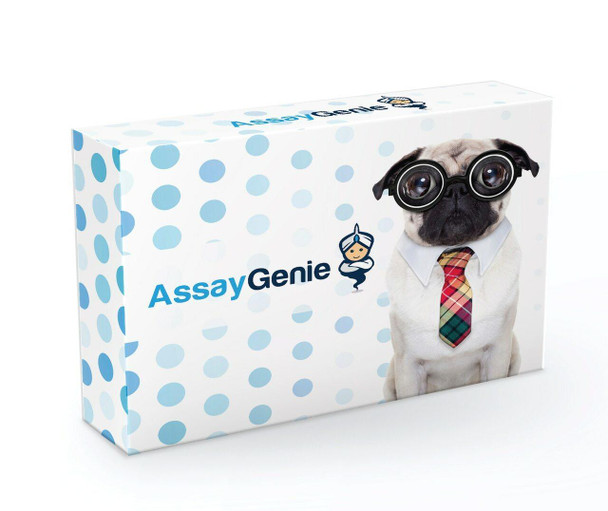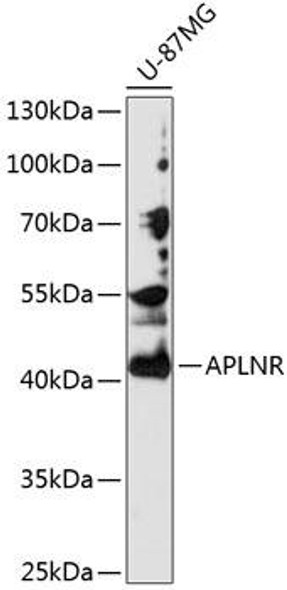Cell Biology Antibodies 14
Anti-APLN Antibody (CAB18168)
- SKU:
- CAB18168
- Product Type:
- Antibody
- Reactivity:
- Human
- Host Species:
- Rabbit
- Isotype:
- IgG
- Research Area:
- Cell Biology
Description
| Antibody Name: | Anti-APLN Antibody |
| Antibody SKU: | CAB18168 |
| Antibody Size: | 20uL, 50uL, 100uL |
| Application: | WB |
| Reactivity: | Human |
| Host Species: | Rabbit |
| Immunogen: | Recombinant protein of human APLN. |
| Application: | WB |
| Recommended Dilution: | WB 1:500 - 1:2000 |
| Reactivity: | Human |
| Positive Samples: |
| Immunogen: | Recombinant protein of human APLN. |
| Purification Method: | Affinity purification |
| Storage Buffer: | Store at -20°C. Avoid freeze / thaw cycles. Buffer: PBS with 0.02% sodium azide, 50% glycerol, pH7.3. |
| Isotype: | IgG |
| Sequence: | Email for sequence |
| Gene ID: | 8862 |
| Uniprot: | Q9ULZ1 |
| Cellular Location: | |
| Calculated MW: | |
| Observed MW: | Refer to figures |
| Synonyms: | APEL, XNPEP2, APLN |
| Background: |
| UniProt Protein Function: | apelin: Endogenous ligand for APJ, an alternative coreceptor with CD4 for HIV-1 infection. Inhibits HIV-1 entry in cells coexpressing CD4 and APJ. Apelin-36 has a greater inhibitory activity on HIV infection than other synthetic apelin derivatives. The oral intake in the colostrum and the milk could have a role in the modulation of the immune responses in neonates. May also have a role in the central control of body fluid homeostasis by influencing AVP release and drinking behavior. Belongs to the apelin family. |
| UniProt Protein Details: | Protein type:Secreted; Secreted, signal peptide Chromosomal Location of Human Ortholog: Xq25 Cellular Component: extracellular space; extracellular region Molecular Function:G-protein-coupled receptor binding; hormone activity; apelin receptor binding; receptor binding Biological Process: lactation; immune response; signal transduction |
| NCBI Summary: | This gene encodes a peptide that functions as an endogenous ligand for the G protein coupled receptor APJ. The encoded protein is synthesized as a prepropeptide that is processed into biologically active C-terminal fragments. The peptide fragments activate different tissue specific signaling pathways that regulate diverse biological functions including fluid homeostasis, cardiovascular function and insulin secretion. This protein also functions as a coreceptor for the human immunodeficiency virus 1.[provided by RefSeq, Feb 2010] |
| UniProt Code: | Q9ULZ1 |
| NCBI GenInfo Identifier: | 20137569 |
| NCBI Gene ID: | 8862 |
| NCBI Accession: | Q9ULZ1.1 |
| UniProt Secondary Accession: | Q9ULZ1,Q4VY08, Q8WU89, |
| UniProt Related Accession: | Q9ULZ1 |
| Molecular Weight: | 8,569 Da |
| NCBI Full Name: | Apelin |
| NCBI Synonym Full Names: | apelin |
| NCBI Official Symbol: | APLN |
| NCBI Official Synonym Symbols: | APEL; XNPEP2 |
| NCBI Protein Information: | apelin; AGTRL1 ligand; APJ endogenous ligand |
| UniProt Protein Name: | Apelin |
| UniProt Synonym Protein Names: | APJ endogenous ligand |
| UniProt Gene Name: | APLN |
| UniProt Entry Name: | APEL_HUMAN |






